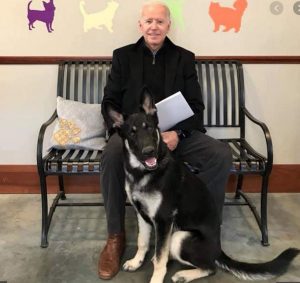Your adorable ball of fluff won’t stay small forever, and eventually your dog will grow large enough to present a significant challenge on leash. It may be cute now, but when your German Shepherd is 85 lbs. and still barreling up to strangers they will not take it quite as kindly. Start working with your pup now! We all know our dogs can’t stay puppies forever, and responsible pet owners prevent problem behaviors from occurring, rather than reacting to them as they become an issue. In this article we will be covering:
- How to Desensitize Your Puppy to Their Walking Equipment.
- The Steps to Take Inside, So Your Dog Listens Outside.
- The Steps to Take Outside, So Your Dog Responds to You On Leash.
- Maintaining Your Pup’s Leash Walking Over Time
By having a full understanding of these four items, you will be able to easily prevent future leash pulling in your German Shepherd puppy. The first step you will need to take is getting your puppy used all this new stimuli.
How To Desensitize Your Puppy to Their Walking Equipment
Start working on this step right away! Don’t wait a few weeks until your puppy is a little older to begin working on desensitization. Your dog should be allowed plenty of time to get used to the sensation of having a collar on, having a harness on, and having a leash attached to them, before we ever try a “formal” leash walking session. Making sure your puppy is comfortable is highly important. Adding stress to your puppy’s walk could potentially cause them to make any number of negative associations. They could become uncomfortable with strange people approaching, simply because the collar was making them itchy and a stranger happened to also be there. Strangers, dogs, cats, cars, loud noises, your dog could accidentally associate virtually anything with that stressful or annoying sensation and create future behavioral problems.
To allow your puppy to become comfortable with these new sensations it is important to begin slowly. Do not attempt to force your pup to wear their new collar for an hour the first time they have it on! Attach the collar, give your pup some treats and cuddles, and then take the collar back off again. Slowly increase the amount of time the collar stays on your puppy, but only if they appear content. We will repeat the same steps with your dog’s harness, and with the leash. Many puppy owners simply leave the collar on at all times to allow the puppy to get used to it, please avoid doing this. Your puppy should only have their collar on while supervised, as it can pose a very serious choking hazard if your dog catches it on something.
The Steps to Take Inside, So Your Dog Listens Outside
Before we take our puppy into the great outdoors (hey, it looks a lot bigger to them than it does to us!) we need to practice a few basics while we are still inside. Puppies are quite easily distracted, but German Shepherds are notorious for their ability to focus, let’s use this to our advantage. If we do not give our dog something to focus on, they will find something else, like a bird, or a squirrel, or a bike, you get the idea… we want their attention on us. Starting inside takes away many of the distractions you may encounter while outside. Dogs are being bombarded by much more sensory stimulus than we are at any given moment, and there are lots of different sounds and smells we can’t detect that are distracting your dog the second you step out the front door.
Rather than maintaining a fraction of your puppy’s attention and setting yourself up for a frustrating training session, begin in your living room or kitchen and use the following simple steps:
- Call your pup’s name, wait a second or two and if he doesn’t look you can clap your hands, snap your fingers, make kissy noises, anything you need to do to get his attention. The noises we use to catch our pup’s attention are called prompting.
- When your pup looks your direction, praise them heavily and reinforce using yummy treats.
- Once your dog is giving you attention when you ask, begin to up the distractions. Call your pup when he is playing with something, or looking out the window.
- Begin walking your dog on the leash inside the house, praising them and giving them small treats.
- Ask for your dog’s attention while on leash inside the house, and when your dog looks at you be sure to praise heavily and reinforce.
- Begin to use your voice to move your dog. Instead of pulling on the leash, call your pup’s name and prompt to get them to move the direction you would like.
The Steps to Take Outside, So Your Dog Responds to You On Leash
Now that your dog has had plenty of indoor practice, he is ready to graduate to outdoor leash walking. It is still important to start small, before building up to high distraction situations. Even if you have a fenced yard, you should take your puppy out on leash to go to the bathroom. Use this as an opportunity for your dog to become more comfortable, and to keep building up the association between going on leash and good things happening. We should also continue using our voice to move our dog, rather than yanking them around with the leash. We will use steps quite similar to when we were indoors:
- Begin in the lowest distraction level. If you have a fenced yard, start back there after your pup has gone to the bathroom. If not, simply walk them anywhere outside and wait until your dog is not distracted by anything.
- Call your pup’s name, wait a second or two and if he doesn’t look you can prompt.
- When your pup looks your direction, praise them heavily and reinforce using yummy treats.
- Once your dog is giving you attention when you ask, begin to up the distractions. Call your pup when he is sniffing at something, or when he has seen or heard something interesting.
- Begin asking for your pup’s attention when they see other dogs or people. Start right when they see the distraction (look at the ears to help you figure this out), and continue asking for their attention as you approach.
- If safe, allow your dog to interact. If unsafe, keep your pup moving past the distraction asking for their attention the entire way.
- Attempt to only use the leash as your back up, your dog should be attentive to you and move along when you speak to him. Use your prompting to get his attention when he doesn’t listen BEFORE you pull on the leash.
Maintaining Your Pup’s Leash Walking Over Time
We have built a strong foundation of behavior with our dog, and we have taught them the proper way to behave while they are outside; but this was only one battle, you haven’t won the war yet! Maintaining a behavior is just as difficult as training it, because it is incredibly easy to forget to do. When your dog is behaving like a model citizen it’s important to remember to let them know how fantastic they are. Keep periodically reinforcing your dog for their good behavior! So many dog owners phase out treats, and then only ever give their dog a pat on the head for their efforts.
Your dog doesn’t give a damn about your lazy pat on the head when there’s a pretty lady dog across the street! He will only maintain the behaviors we have taught him if he is getting a little something every once in a while to keep him motivated. Reinforce your dog sporadically for being a great pup, and you will have a beautiful, long-lasting behavioral repertoire.




